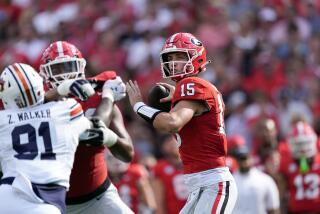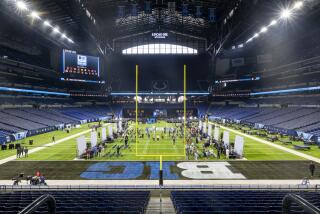NCAA, NBA take on youth basketball
SAN ANTONIO -- The NCAA and the NBA, organizations that once barely spoke to each other, are combining forces to try to shape what NCAA President Myles Brand called the “dysfunctional” world of youth basketball.
The groups will invest a minimum of $15 million each over the next five years to fund an as-yet-unnamed corporation that will seek to provide training and oversight of coaches and officials and educate young athletes and their families about what has been a murky world of competing interests.
“The end product will be we are going to work to develop, both on the court and off the court, the skills of young players who ultimately make it to the NBA or that don’t,” NBA Commissioner David Stern said.
Brand and Stern have formed a coalition of groups that rarely cooperated in the past, including representatives of Nike and Adidas, the Amateur Athletic Union and USA Basketball.
The two also agreed they would prefer players be required to stay in college two years instead of one before becoming eligible for the NBA draft, but that remains a collective-bargaining issue with the NBA Players Assn. Negotiations on a new agreement won’t begin for at least three years, Stern said.
“That’s not the highest priority,” he said. “I still say [age] 20 is better than 19,” but “we asked for it last time and didn’t get it.”
Dan Wasserman, a spokesman for the players’ association, said in a telephone call that the union had been briefed last week by NBA officials on the presentation it would make today, but that league officials said they understood the players’ opposition to raising the age rule and didn’t intend to propose changes.
“The union membership has historically been overwhelmingly opposed to raising the age limitation by a margin of over 90% of the membership,” Wasserman said.
“In 2005 we agreed to raise the age to 19 literally at the eleventh hour of bargaining [in return for NBA concessions that increased the salary cap]. . . . It is highly doubtful that the league or the union would open up negotiations during the CBA, just for one issue. It has never been done before and there has been no discussion of it happening now.
“Never say never, but it is not on the radar or in our crystal balls.”
Georgia Tech Coach Paul Hewitt called the cooperation among the NCAA, NBA and other groups a dramatic development for youth basketball, an arena in which he said players are often poorly coached and poorly informed.
“I can’t tell you how many kids I met on the AAU trail in Vegas or Orlando who I come across later when they’re 28 years old and they say, ‘If I only knew then what I know now,’ ” Hewitt said.
Among those present at the announcement were representatives of shoe companies that have been scapegoats for youth basketball’s ills, including Jim Gatto of Adidas and George Raveling of Nike, who was instrumental in forging the NCAA-NBA alliance.
Also there was Boo Williams, chairman of boys’ basketball for the AAU, an organization that is bothered that AAU became a synonym for summer basketball, much like Coca-Cola is for soda, Williams said.
“Everything that goes on in the spring and summer is not AAU basketball,” Williams said.
The new coalition’s plans were questioned for being short on specifics, but the NCAA sought to use the stage of the Final Four to focus attention on the effort.
“It’s taken a long time to get into the situation where we are with youth basketball, and it will not be solved overnight,” Brand said.
UCLA Athletic Director Dan Guerrero, a member of the NCAA men’s basketball committee, attended the announcement and said, “It’s step one of a long journey.”
--
More to Read
Go beyond the scoreboard
Get the latest on L.A.'s teams in the daily Sports Report newsletter.
You may occasionally receive promotional content from the Los Angeles Times.










